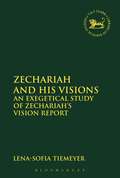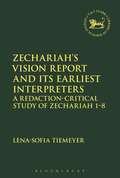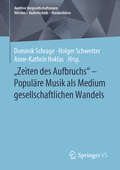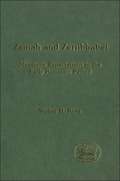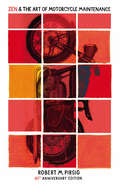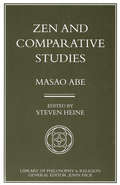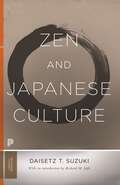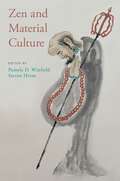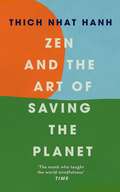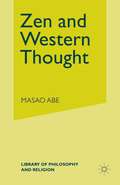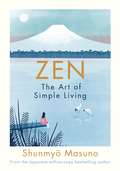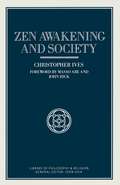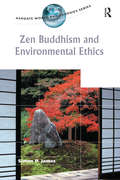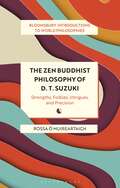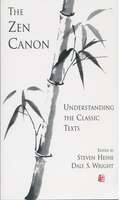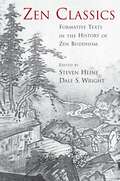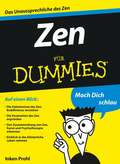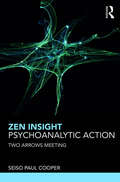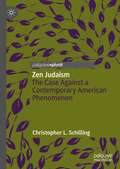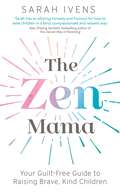- Table View
- List View
Zechariah and His Visions: An Exegetical Study of Zechariah's Vision Report (The Library of Hebrew Bible/Old Testament Studies #605)
by Lena-Sofia TiemeyerDid Zechariah really see visions? This question cannot be definitely answered, so the idea must remain a hypothesis. Here, Tiemeyer shows that this hypothesis is nonetheless reasonable and instrumental in shedding light on matters in Zechariah's vision report that are otherwise unclear. Tracking through each verse of the text, the key exegetical problems are covered, including the topics of the distinction between visions and dreams, dream classification, conflicting sources of evidence for dream experiences, and rhetorical imagery as opposed to dream experience. Further attention is focused on the transmission of the divine message to Zechariah, with the key question raised of whether a visual or oral impression is described. Tiemeyer's study further demonstrates that Zech 1-6 depicts a three-tier reality. This description seeks to convey the seer's visionary experience to his readers. In a trance state, Zechariah communicates with the Interpreting Angel, while also receiving glimpses of a deeper reality known as the 'visionary world.'
Zechariah’s Vision Report and Its Earliest Interpreters: A Redaction-Critical Study of Zechariah 1-8 (The Library of Hebrew Bible/Old Testament Studies #626)
by Lena-Sofia TiemeyerIf Zechariah's vision report (Zechariah 1.8-6.8) reflects the seer's visionary experience, how does that impact our understanding of the gradual growth of the text? Lena-Sofia Tiemeyer builds on the work done in her previous book Zechariah and His Visions (Bloomsbury-T&T Clark, 2014), to demonstrate that the visionary material forms the primary textual layer. The oracular texts constitute chronologically later interpretations. Zechariah and/or later authors/editors sought guidance in the earlier vision accounts, and the oracular material reflects these endeavours. Tiemeyer's investigation is guided by the question: what is the latter material doing with the former? Is it enforcing, contradicting, or adding to it? Using a ratio composed of the difference between the intratexts and intertexts of Zech 1-8, Tiemeyer shows how this ratio is higher in the oracular material than in the visionary material. This difference points to the different origin and the different purpose of the two sets of material. While the earlier vision report draws on images found primarily in other biblical vision reports, the later oracular material has the characteristics of scribal interpretation. By drawing on earlier material, it seeks to anchor its proposed interpretations of the various vision accounts within the Israelite textual tradition. It is clear that the divine oracles were added to give, modify, and specify the meaning of the earlier vision report.
"Zeiten des Aufbruchs" - Populäre Musik als Medium gesellschaftlichen Wandels (Auditive Vergesellschaftungen Hörsinn - Audiotechnik - Musikerleben)
Dieser Band fragt nach dem Beitrag der populären Musik zu den gesellschaftlichen Transformationen der 1960er bis 1980er Jahre und verbindet kultursoziologische, musik- und kulturwissenschaftliche Perspektiven. Welchen neuartigen Erlebensweisen, welchen sozialen Akteursgruppen verschafft Musik Geltung? Viele zeitgenössische Akteure, aber auch akademische Arbeiten deuten das Auftreten neuer Musikstile (Beat, Rock, Punk etc.) auf der Bühne der Geschichte als Bestandteil eines befürworteten gesellschaftlichen „Aufbruchs“ (jeweils neuer Generationskohorten). Der Band beobachtet diese Metapher des Aufbruchs indes als eine feldtypische Deutung, anhand derer das Zusammenwirken von Musik und gesellschaftlichen Transformationen bereits kenntlich wird.
Zemah and Zerubbabel: Messianic Expectations in the Early Postexilic Period (The Library of Hebrew Bible/Old Testament Studies)
by Wolter H. RoseIt has often been argued that Zerubbabel, the Jewish governor of Yehud at the time of the rebuilding of the temple (late 6th century BCE), was viewed by the prophets Haggai and Zechariah as the new king in the line of David. In this new study, Rose offers a contrary proposal for the interpretation of the oracles in Haggai 2 and Zechariah 3 and 6. He traces their background in the pre-exilic prophets, pays special attention to often neglected details of semantics and metaphor, and concludes that neither Haggai nor Zechariah designated Zerubbabel as the new king in Jerusalem. Instead, the oracles in Zechariah 3 and 6 should be seen as fully messianic.
Zen And The Art Of Motorcycle Maintenance: 40th Anniversary Edition (P. S. Series)
by Robert PirsigAcclaimed as one of the most exciting books in the history of American letters, this modern epic became an instant bestseller upon publication in 1974, transforming a generation and continuing to inspire millions. A narration of a summer motorcycle trip undertaken by a father and his son, the book becomes a personal and philosophical odyssey into fundamental questions of how to live. Resonant with the confusions of existence, Zen and the Art of Motorcycle Maintenance is a touching and transcendent book of life.
Zen and Comparative Studies (Library of Philosophy and Religion)
by M. AbeZen is not a religion of God. Nor a religion of faith. It is a religion of emptiness, a religion of absolute nothingness. However it is not nihilistic but dynamically positive. For Zen is based on self-awakening, awakening to the self. In this book, a sequel to Zen and Western Thought, the author tries to clarify the true meaning of Buddhist emptiness in comparison with Aristotelian notion of substance and Whiteheadron notion of process. He also emphasises that Buddhism completely defies and overcomes dualism, but it is not monistic, but rather nondualistic. What is Nondualism? This is one of the important themes of this book.
Zen and Japanese Culture (Bollingen Series #334)
by Daisetz T. SuzukiZen and Japanese Culture is a classic that has influenced generations of readers and played a major role in shaping conceptions of Zen’s influence on Japanese traditional arts. In simple and poetic language, Daisetz Suzuki describes Zen and its historical evolution. He connects Zen to the philosophy of the samurai, and subtly portrays the relationship between Zen and swordsmanship, haiku, tea ceremonies, and the Japanese love of nature. Suzuki uses anecdotes, poetry, and illustrations of silk screens, calligraphy, and architecture. The book features an introduction by Richard Jaffe that acquaints readers with Suzuki’s life and career and analyzes the book’s reception in light of contemporary criticism, especially by scholars of Japanese Buddhism. Zen and Japanese Culture is a valuable source for those wishing to understand Zen in the context of Japanese life and art, and remains one of the leading works on the subject.
Zen and Japanese Culture: Not Assigned (Bollingen Series (General) #334)
by Daisetz T. Suzuki Richard M. JaffeZen and Japanese Culture is a classic that has influenced generations of readers and played a major role in shaping conceptions of Zen’s influence on Japanese traditional arts. In simple and poetic language, Daisetz Suzuki describes Zen and its historical evolution. He connects Zen to the philosophy of the samurai, and subtly portrays the relationship between Zen and swordsmanship, haiku, tea ceremonies, and the Japanese love of nature. Suzuki uses anecdotes, poetry, and illustrations of silk screens, calligraphy, and architecture. The book features an introduction by Richard Jaffe that acquaints readers with Suzuki’s life and career and analyzes the book’s reception in light of contemporary criticism, especially by scholars of Japanese Buddhism. Zen and Japanese Culture is a valuable source for those wishing to understand Zen in the context of Japanese life and art, and remains one of the leading works on the subject.
Zen and Material Culture
by Pamela D. Winfield Steven HeineThe stereotype of Zen Buddhism as a minimalistic or even immaterial meditative tradition persists in the Euro-American cultural imagination. This volume calls attention to the vast range of "stuff" in Zen by highlighting the material abundance and iconic range of the Soto, Rinzai, and Obaku sects in Japan. Chapters on beads, bowls, buildings, staffs, statues, rags, robes, and even retail commodities in America all shed new light on overlooked items of lay and monastic practice in both historical and contemporary perspectives. Nine authors from the cognate fields of art history, religious studies, and the history of material culture analyze these "Zen matters" in all four senses of the phrase: the interdisciplinary study of Zen's matters (objects and images) ultimately speaks to larger Zen matters (ideas, ideals) that matter (in the predicate sense) to both male and female practitioners, often because such matters (economic considerations) help to ensure the cultural and institutional survival of the tradition. Zen and Material Culture expands the study of Japanese Zen Buddhism to include material inquiry as an important complement to mainly textual, institutional, or ritual studies. It also broadens the traditional purview of art history by incorporating the visual culture of everyday Zen objects and images into the canon of recognized masterpieces by elite artists. Finally, the volume extends Japanese material and visual cultural studies into new research territory by taking up Zen's rich trove of materia liturgica and supplementing the largely secular approach to studying Japanese popular culture. This groundbreaking volume will be a resource for anyone whose interests lie at the intersection of Zen art, architecture, history, ritual, tea ceremony, women's studies, and the fine line between Buddhist materiality and materialism.
Zen and the Art of Saving the Planet
by Thich Nhat Hanh'The monk who taught the world mindfulness' TimeIn this masterful work, one of the most revered spiritual leaders in the world today shares his wisdom on how to be the change we want to see in the world. In these troubling times we all yearn for a better world. But many of us feel powerless and uncertain what we can do. Thich Nhat Hanh (Thay) is blazingly clear: there's one thing that we have the power to change-and which can make all the difference: our mind. How we see and think about things determines all the choices we make, the everyday actions we take (or avoid), how we relate to those we love (or oppose), and how we react in a crisis or when things don't go our way.Filled with powerful examples of engaged action he himself has undertaken, inspiring Buddhist parables, and accessible daily meditations, this powerful spiritual guide offers us a path forward, opening us to the possibilities of change and how we can contribute to the collective awakening and environmental revolution our fractured world so desperately needs.
Zen and Western Thought: A Third Sequel To Zen And Western Thought (Library of Philosophy and Religion)
by Masao AbeZen: The Art of Simple Living
by Shunmyo Masuno'Does for mental clutter what Marie Kondo has done for household clutter' Publisher's WeeklyA beautifully illustrated guide to slowing down, finding true happiness and feeling calm, by Zen Buddhist monk Shunmyo Masuno. _________Zen is the perfect antidote to the chaos of modern life . . . In clear, practical and easy to follow lessons - one a day for 100 days - renowned Buddhist monk Shunmyo Masuno draws on centuries of wisdom to show you how to apply the essence of Zen to modern life. You will learn how to exhale deeply to eliminate negative emotions, to arrange your house simply to clear your thinking, to line up your shoes at night to bring order to your mind, to plant a single flower and watch it grow, to worry less about what you cannot control, and so much more . . .You will even make time to think about nothing at all.Simplify your life with the art of Zen, and learn how to feel more relaxed, fulfilled, and with a renewed sense of peace. __________'This little treasure needs to be at every bedside' llan Lokos, author of Through the Flames, Patience, and Pocket Peace'Zen: The Art of Simple Living makes the wisdom of the Buddha radically accessible' Dzogchen Ponlop Rinpoche, author of Emotional Rescue and Rebel Buddha
Zen Awakening and Society (Library of Philosophy and Religion)
by Christopher IvesZen Buddhism has traditionally focused on monastic practice and the artistic expression of awakening (satori) but has paid little explicit attention to social ethics. This book considers the relationship between Zen and social ethics.
Zen Buddhism and Environmental Ethics (Ashgate World Philosophies Series)
by Simon P. JamesZen Buddhism and Environmental Ethics explores the implications of Zen Buddhist teachings and practices for our moral relations with the natural world. At once an accessible introduction to Zen and an important contribution to the debate concerning the environmental implications of the tradition, this book will appeal both to readers unfamiliar with East Asian thought and to those well versed in the field. In elucidating the philosophical implications of Zen, the author draws upon both Eastern and Western philosophy, situating the Zen understanding of nature within the Buddhist tradition, as well as relating it to the ideas of key Western philosophers such as Aristotle, Kant and Heidegger. These philosophical reflections on Zen are used to shed light on some prominent debates in contemporary environmental ethics concerning such issues as the intrinsic value of nature.
Zen Buddhism and Environmental Ethics (Ashgate World Philosophies Series)
by Simon P. JamesZen Buddhism and Environmental Ethics explores the implications of Zen Buddhist teachings and practices for our moral relations with the natural world. At once an accessible introduction to Zen and an important contribution to the debate concerning the environmental implications of the tradition, this book will appeal both to readers unfamiliar with East Asian thought and to those well versed in the field. In elucidating the philosophical implications of Zen, the author draws upon both Eastern and Western philosophy, situating the Zen understanding of nature within the Buddhist tradition, as well as relating it to the ideas of key Western philosophers such as Aristotle, Kant and Heidegger. These philosophical reflections on Zen are used to shed light on some prominent debates in contemporary environmental ethics concerning such issues as the intrinsic value of nature.
The Zen Buddhist Philosophy of D. T. Suzuki: Strengths, Foibles, Intrigues, and Precision (Bloomsbury Introductions to World Philosophies)
by Rossa Ó MuireartaighD.T. Suzuki (1870-1966) reached global fame for his writings on Zen Buddhism. In this introduction to his theories of self, knowledge, and the world, Suzuki is presented as a Buddhist philosopher in his own right.Beginning with a biography of his life providing the historical context to his thought and discussing Suzuki's influences, chapters cover the Zen notion of the non-self and Suzuki's Zen view of consciousness, language, and religious truths. His ideas about philosophy and radical views on rationality and faith come to life in two new complete translations of The Place of Peace in our Heart (1894) and Science and Religion (1949), which helps us to understand why Suzuki's description of Zen attracted the attention of many leading intellectuals and helped it become a household name in the English-speaking world.Offering the first complete overview of Suzuki's approach, reputation, and legacy as a philosopher, this is for anyone interested in the philosophical relevance and development of Mahayana Buddhism today.
The Zen Buddhist Philosophy of D. T. Suzuki: Strengths, Foibles, Intrigues, and Precision (Bloomsbury Introductions to World Philosophies)
by Rossa Ó MuireartaighD.T. Suzuki (1870-1966) reached global fame for his writings on Zen Buddhism. In this introduction to his theories of self, knowledge, and the world, Suzuki is presented as a Buddhist philosopher in his own right.Beginning with a biography of his life providing the historical context to his thought and discussing Suzuki's influences, chapters cover the Zen notion of the non-self and Suzuki's Zen view of consciousness, language, and religious truths. His ideas about philosophy and radical views on rationality and faith come to life in two new complete translations of The Place of Peace in our Heart (1894) and Science and Religion (1949), which helps us to understand why Suzuki's description of Zen attracted the attention of many leading intellectuals and helped it become a household name in the English-speaking world.Offering the first complete overview of Suzuki's approach, reputation, and legacy as a philosopher, this is for anyone interested in the philosophical relevance and development of Mahayana Buddhism today.
The Zen Canon: Understanding the Classic Texts
by Dale S. WrightBodhidharma, its first patriarch, reputedly said that Zen Buddhism represents "a special transmission outside the teaching/Without reliance on words and letters." This saying, along with the often perplexing use of language (and silence) by Zen masters, gave rise to the notion that Zen is a "lived religion," based strictly on non-linguistic practice and lacking a substantial canon of sacred texts. Even those who recognize the importance of Zen texts commonly limit their focus to a few select texts without recognizing the wide variety of Zen literature. This collection of previously unpublished essays argues that Zen actually has a rich and varied literary heritage. Among the most significant textual genres are hagiographic accounts and recorded sayings of individual Zen masters, koan collections and commentaries, and rules for monastic life. During times of political turmoil in China and Japan, these texts were crucial to the survival and success of Zen, and they have for centuries been valued by practitioners as vital expressions of the truth of Zen. This volume offers learned yet accessible studies of some of the most important classical Zen texts, including some that have received little scholarly attention (and many of which are accessible only to specialists). Each essay provides historical, literary, and philosophical commentary on a particular text or genre. Together, they offer a critique of the "de facto canon" that has been created by the limited approach of Western scholarship, and demonstrate that literature is a diverse and essential part of Zen Buddhism.
The Zen Canon: Understanding the Classic Texts
by Dale S. WrightBodhidharma, its first patriarch, reputedly said that Zen Buddhism represents "a special transmission outside the teaching/Without reliance on words and letters." This saying, along with the often perplexing use of language (and silence) by Zen masters, gave rise to the notion that Zen is a "lived religion," based strictly on non-linguistic practice and lacking a substantial canon of sacred texts. Even those who recognize the importance of Zen texts commonly limit their focus to a few select texts without recognizing the wide variety of Zen literature. This collection of previously unpublished essays argues that Zen actually has a rich and varied literary heritage. Among the most significant textual genres are hagiographic accounts and recorded sayings of individual Zen masters, koan collections and commentaries, and rules for monastic life. During times of political turmoil in China and Japan, these texts were crucial to the survival and success of Zen, and they have for centuries been valued by practitioners as vital expressions of the truth of Zen. This volume offers learned yet accessible studies of some of the most important classical Zen texts, including some that have received little scholarly attention (and many of which are accessible only to specialists). Each essay provides historical, literary, and philosophical commentary on a particular text or genre. Together, they offer a critique of the "de facto canon" that has been created by the limited approach of Western scholarship, and demonstrate that literature is a diverse and essential part of Zen Buddhism.
Zen Classics: Formative Texts in the History of Zen Buddhism
by Steven Heine Dale S. WrightThis is a companion volume to The Koan and The Zen Canon, by the same editors. The first volume collected original essays on koan collections, recorded sayings of individual masters, histories of major schools, and compilations of monastic regulations. The second focuses on the early history of Zen in China, providing overview assessments of many of the most important canonical texts that set the Zen tradition in motion throughout East Asia. Zen Classics will follow that historical movement, focusing primarily on texts from Korea and Japan that brought this Buddhist movement to fruition. Although enormously diverse in style and structure all of the texts and genres of texts considered here were fundamental to the unfolding of Zen in East Asia. The range of genres reveals the varieties of Zen practice, from rules of daily practice to sermons and meditation manuals. The all new essays in this volume will be contributed by an international team of distinguished scholars of Buddhism. It is aimed at broad audience including college students, Zen practitioners, and scholars of East Asian history, religion, and culture, as well as specialists in Buddhist history.
Zen für Dummies (Für Dummies)
by Inken ProhlWas bringt Menschen dazu, stundenlang regungslos auf einem Kissen zu sitzen? Die Faszination des Zen-Buddhismus ist groß, da nimmt so mancher Beschwernisse auf sich bei der Suche nach Erkenntnis. Inken Prohl hat das Unaussprechliche des Zen in leicht verständliche Worte gefasst. Sie zeigt, warum das angebliche "Nichts" des Zen - keine Lehre und keine Antworten - gerade für westliche Sinnsuchende so attraktiv ist, was es mit der besonderen Beziehung zwischen Schüler und Meister auf sich hat und wie die vollkommene innere Befreiung erreicht werden kann.
Zen Insight, Psychoanalytic Action: Two Arrows Meeting
by Seiso Paul CooperDrawing from original source material, contemporary scholarship, and Wilfred Bion’s psychoanalytic writings, Zen Insight, Psychoanalytic Action: Two Arrows Meeting introduces the Zen notion of "gūjin," or total exertion, and elaborates a realizational perspective that integrates Zen Buddhism and psychoanalysis. Developed by the thirteenth century Zen teacher and founder of the Japanese Soto Zen school, Eihei Dogen, gūjin finds expression and is referenced in various contemporary scholarly and religious commentaries. This book explains this pivotal Zen concept and addresses themes by drawing from translated source material, academic scholarship, traditional Zen kōans and teaching stories, extensive commentarial literature, interpretive writings by contemporary Soto Zen teachers, psychoanalytic theory, clinical material, and poetry, as well as the author’s thirty years of personal experience as a psychoanalyst, supervisor, psychoanalytic educator, ordained Soto Zen priest, and transmitted Soto Zen teacher. From a realizational perspective that integrates Zen and psychoanalytic concepts, the book addresses anxiety-driven interferences to deepened Zen practice, extends the scope and increases the effectiveness of clinical work for the psychotherapist, and facilitates deepened experiences for both the Buddhist and the secular meditation practitioner. Two Arrows Meeting will be of great interest to researchers in the fields of Zen Buddhism and psychoanalysis. It will also appeal to meditation practitioners and psychoanalysts in practice and training.
Zen Insight, Psychoanalytic Action: Two Arrows Meeting
by Seiso Paul CooperDrawing from original source material, contemporary scholarship, and Wilfred Bion’s psychoanalytic writings, Zen Insight, Psychoanalytic Action: Two Arrows Meeting introduces the Zen notion of "gūjin," or total exertion, and elaborates a realizational perspective that integrates Zen Buddhism and psychoanalysis. Developed by the thirteenth century Zen teacher and founder of the Japanese Soto Zen school, Eihei Dogen, gūjin finds expression and is referenced in various contemporary scholarly and religious commentaries. This book explains this pivotal Zen concept and addresses themes by drawing from translated source material, academic scholarship, traditional Zen kōans and teaching stories, extensive commentarial literature, interpretive writings by contemporary Soto Zen teachers, psychoanalytic theory, clinical material, and poetry, as well as the author’s thirty years of personal experience as a psychoanalyst, supervisor, psychoanalytic educator, ordained Soto Zen priest, and transmitted Soto Zen teacher. From a realizational perspective that integrates Zen and psychoanalytic concepts, the book addresses anxiety-driven interferences to deepened Zen practice, extends the scope and increases the effectiveness of clinical work for the psychotherapist, and facilitates deepened experiences for both the Buddhist and the secular meditation practitioner. Two Arrows Meeting will be of great interest to researchers in the fields of Zen Buddhism and psychoanalysis. It will also appeal to meditation practitioners and psychoanalysts in practice and training.
Zen Judaism: The Case Against a Contemporary American Phenomenon
by Christopher L. SchillingContemporary Judaism is transforming, especially in America, from a community experience to more of a do-it-yourself religion focused on the individual self. In this book Christopher L. Schilling offers a critique of this transformation. Schilling discusses problematic aspects of Jewish mindfulness meditation, and the relationship between Judaism and psychedelics, proceeding to explore the science behind these developments and the implications they have for Judaism.
The Zen Mama: Your guilt-free guide to raising brave, kind children
by Sarah IvensLet go of parenting expectations and fears to raise courageous, confident children.The Zen Mama philosophy is that mother and child complement each other in adventures and experiences, always putting safety first but without getting caught up in the anxieties, drama, impossible expectations and mental baggage that too often comes along with modern parenting. Learning to become a Zen Mama will help you grow and nurture a Zen Child - someone who isn't afraid to be different, who can stand up for himself or his friends, and can travel the world and experiment with new things without being overwhelmed with self-doubt or being scared. Full of facts, actionable advice and practical tips, this book will be about combining the heart and the head with what works for you and your family, not comparing yourselves to others or meeting a societal standard. It will support and nurture the mother's journey like a wise and sympathetic friend and offers ideas and experience rather than judgement.The Zen Mama will help you to find your purpose as a mother. It will instil the self-belief you need to help create a resilient, creative, caring and smart child - and help to survive the journey.
